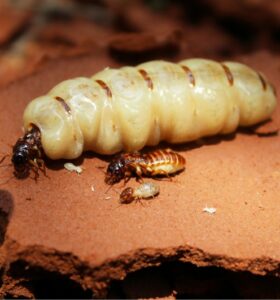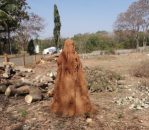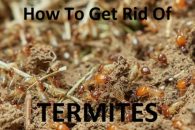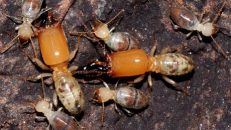Termites are a type of insect that you can find all over the United States, but they’re a bigger problem in the south.
If you live in the far north, you’re not as likely to encounter these pests but for the rest of us, we’re likely to have some form of interaction with them at least once per year.
So, let’s get into the fundamentals.
Termites are a eusocial species, this means that they live in colonies and are a highly organised group dependant on sociality.
Primarily they are split into 3 groups:
Contents
Workers
Worker termites are the most common in the colonies, but there is some types of termites that do not have a worker class.
Workers are the ones that eat the wood, so when you break open a piece of rotten wood and find termites inside, these are the type that you will encounter.
The colonies that work above ground use mud to create a complex pipeline, this is to cover their trails and to protect them from predators – mainly ants.
You might be wondering, if they eat all the food, how does the rest of the colony survive?
Well, another job that the workers do is ensuring that the rest of the colony is fed.
Repairs are conducted by them, any time there is damage to the external walls.
How long will a worker live?
1 to 2 years is the usual life span for a worker, this is much longer than usual insects and part of this is down to them having very protective nests.
Soldiers
Soldier termites are easily recognisable by their huge heads and jaws, which are scientifically known as mandibles.
Without the worker termites, soldiers are useless as they cannot feed themselves due to the size of their mandibles – they literally can’t put food in their own mouths.
Soldiers tend to make up around 2% of the colony members, it’s not truly known how this is managed but many scientists believe that the queen gives off a pheromone which helps control the ratios.
This low percentage of soldiers can be a problem for colonies as it’s quite easy for them to be overrun by intruders due to the lack of numbers.
What’s the role of a soldier termite?
The primary purpose of soldiers is to protect the colony, primarily from ants as they are the main predator of termites.
Some species have a sticky substance that they can spray their enemies with to entrap them temporarily, allowing the colony to attack the intruder.
How long will a soldier live?
Soldiers tend to live 1 to 2 years but there’s a lot of risks they take on to fulfil their duty – such as fighting off predatory insects/animals.
Do soldier termites bite?
Short answer, yes.
However, they only bite when threatened as I’ve stated before, they cannot feed themselves.
Soldiers primarily only bite invaders to their colony – mainly predators. But it’s not uncommon for a human to be bitten if they are handling them, so it’s not advised unless you have gloves.
Don’t expect much pain from the bite, but it’s not pleasurable.
If you’re bitten, you can expect just a minor irritation and pain but it’s highly unlikely of them to be spreading any diseases.
Reproducers
The name is the biggest clue for this type, they ensure the colony grows.

They will spend all their day laying eggs, this can be at a rate of 1 egg every 3 seconds, that translates to around 30,000 eggs per day, or nearly 11 million per year – can you imagine that?
Colonies first begin with two termites, male and female that have both flew from separate nests, this is known as the nuptial flight.
When they first meet, they make a life long commitment to each other and in the termite world this is final. Should one of them die, so will the other.
It’s a brutal world but you must admire the loyalty of these social insects.
They begin with shedding their wings and then start to burrow into the ground before creating a small nest where the first brood will be born.
Males will impregnate the female straight away, but it can take up to 5 years for a termite colony to fully develop.
How many reproducers are in a colony?
Usually there is only on reproductive couple but when colonies become so huge, there’s often secondary reproductive couples as the queen will not be able to give birth to more termites than there are deaths.
The queen has ultimate control over what the brood develop into – she does this through pheromones.
How long will a termite queen live?
Queens can live from 25 to 50 years, this all depends on how well the colony develops over the years. A new queen will emerge when the old one dies as the blocking pheromone will no longer be produced.






